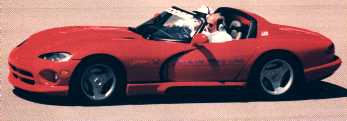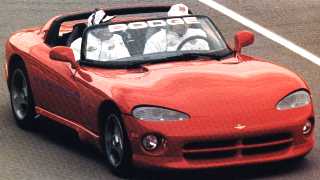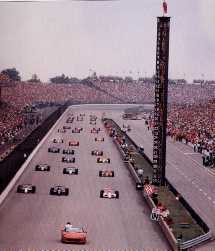![]()
![]()

1991 Dodge Viper RT/10

First seen at the North American Auto Show in Detroit in 1989, the Dodge Viper was a smash bit. Almost instantly letters and deposit checks began rolling in, urging Chrysler to build the car. In May 1990, Chrysler chairman Lee Iacocca gave the Viper the official "go-ahead," and challenged Team Viper to begin production by late l991—only three short years from the time the first Viper concept car was displayed.
Meanwhile, Dodge was preparing to pace the 1991 Indy 500 with its new Stealth sports car. The Stealth surely had ah the right components to be a pace car. It was low and wide with aggressive tires and an engine that produced 300 horsepower. In addition, it was equipped with permanent four-wheel drive and a four-wheel steering system. The only problem was that is was built in Japan alongside the similar Mitsubishi 3000GT
Not too long before the 500 (in fact, after the original Stealth pace car press kits had been mailed), Dodge and IMS decided that it would be better to have an all-American car pace the 500. In stepped the Viper.
The Viper was a natural, the only problem was getting one ready by May Since the Viper wouldn’t go into production for almost two more years, the pace car was a prototype and still carried a few of the show-car trim pieces.
One thing the pace car shared with the production model was its 8.0-liter V-10 engine. Massaged by Lamborghini to produce 400 horsepower and 450 pounds-feet of torque,
Specifications
Body estyle: 2-door roadster
Engine: 488-cid ohv V-lO
Bore X Stroke (ln): 4.00 X 3.88
Horsepower: 400 (SAE net)
Transmission: 6-speed manual
Driver: Carroll Shelby
this engine was one of the largest motors in pace car history Dodge also fitted the Viper with 17-inch wheels wearing the widest rubber around. Without a doubt, the Viper will go down in speedway history as one of the most famous pace cars.
The Driver: Though he never competed in the Indy 500, Carroll Shelby was one of the most accomplished road racers of the 1950s. During that decade he had a record 19 straight victories, won three national championships, held numerous speed records at the Bonneville Salt Flats and won the famous 24 Hours of LeMans.
The Race: Rick Mears took his record-tying fourth Indianapolis
500, finishing just a few seconds ahead of Michael Andretti. As in his 1988
victory Mears was in a Chevrolet-powered Penske car.
Mears, who had been dogging the leaders all day finally passed Andretti on lap 188 and had built up a 2.7-second lead by lap 191. However, Michael’s dad, Mario, blew his engine on lap 191 and that set up a dash to the finish. But when the track went green, Mears would have none of it and powered into turn one and on to victory.


Back
to Main Index
![]() [email protected]
[email protected]